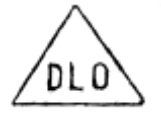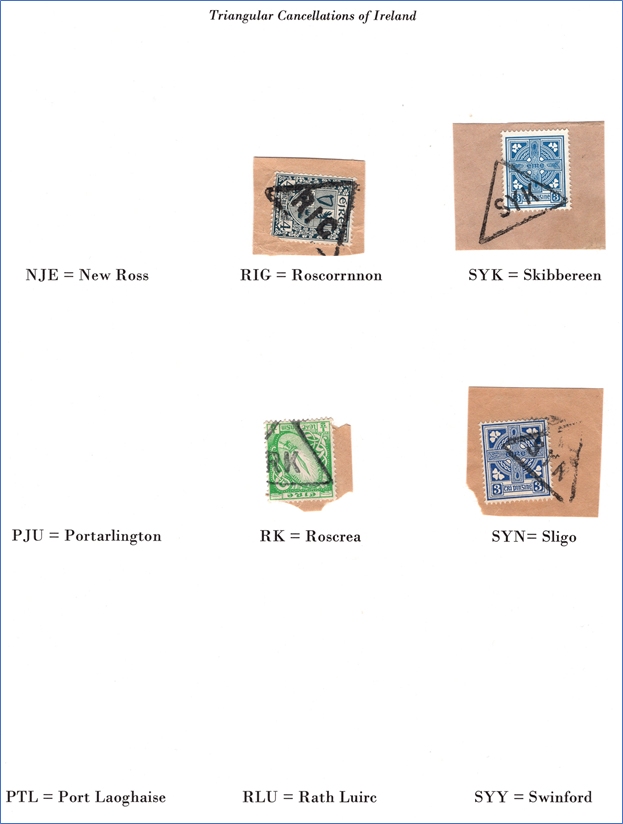The Triangle Cancellations
of Ireland
By Christopher J. Palermo

This paper explores the use of triangle-shaped postal cancellations on wrappers of newspapers and other printed materials in the territory of Ireland based upon secondary sources and the author’s collection.
In England and Ireland before 1855, newspapers and similar printed materials passed through the postal system free. The cost of their transportation was indirectly covered in a tax, which had been levied since 1712, and was denoted by a red stamp impressed on the front page of the paper.
By 1855, this tax came to be viewed as a tax on knowledge. The tax was made optional, and newspapers not showing the tax stamp were transported at Book Post rates, which was inexpensive but offered slow delivery times. Advertising circulars and samples also had the same rates. These rates were reduced in 1866 in a step to undercut pricing of private circular delivery companies that had sprung up; these would be roughly equivalent to today’s firms that deliver flyers door-to-door.
In 1870, the Post Office adopted a second-class, halfpenny rate for newspapers, circulars and other printed matter. A wonderfully enlightened development, this change spurred massive growth in printing and circulation of newspapers. While service still was not time-sensitive, it was so cheap that it permitted publishers of even small-run papers to thrive.
To qualify for the printed matter rate, items had to be printed, and meet several other regulations. By 1895, typewriters and duplicating machines were coming into wide use, so the Post Office enlarged the criteria to include items reproduced from typewriting. All printed matter had to be sent in unsealed envelopes in a minimum bulk number, and had to be deposited at the head office or one of the larger branch or sub-branch offices for cancellation in a distinctive matter.
Numeric identifiers of each post office were adopted in 1844 across the British Isles, then were dropped in 1906. Therefore, at first, post offices used round numeral obliterators as cancellations.
Triangular handstamps for canceling newspapers, made of brass, then were provided to major city and branch post offices and their marks appear on wrappers starting in about 1895. An isosceles triangle form, about 1” per side, was adopted. See Attachment 1 for examples. The triangle presumably means that the items conform to regulations. The triangle markings undated, because the low rate did not involve time-sensitive transportation so the date and time of processing was considered unimportant.
Each triangle included a location designation. Block letters most commonly appear in triangle cancels, but a few are known with script cancellations; these include HS and WG from Hastings and Worthing, England, respectively.
The first triangle cancellation devices bore the telegraph code of the processing office, using a 2-letter or 3-letter abbreviation. Two sizes of triangle handstamps are known; the smaller size sometimes has punctuation.
Often, the telegraph code provides no hint about the name of the office with which it is associated; like many of today’s international airport identifiers, the initials do not necessarily serve as a mnemonic for the location. An essential resource for decoding these identifiers is Mackay, “Telegraphic Codes of the British Isles” (1981), which has a detailed listing running a few hundred pages. Unfortunately, this publication is out of print and difficult to find; it is found at the Royal Philatelic Society London and other major philatelic libraries. Since the basic data in Mackay is not subject to copyright in the United States, a good service to philately would be to make this data available online.
Location codes sometimes changed over time. When southern Ireland was a British possession, Dublin used the 2-letter code DN until 1922; after adoption of the Irish name Baile Atha Cliath, the code was altered to BAC, which can be found in several different kinds of triangular stamps.
Triangles may be found from a few offices which show their 1844 type office number (obsolete after 1906) in combination with their telegraph code letters. An example is CTV 104. Though the number system was not extended immediately after 1906, numbers continued to be used in obliterators for many more years.
The use of telegraph codes was phased out from 1924 and replaced by new numeral codes according to a completely revised list originally intended just for the UK; however, some Irish offices received number assignments anyway. The revised list was inspired largely by the need to separate the numbers used in Northern Ireland from those in the Free State and to identify clearly the ones used in Scotland. To avoid confusion among the Republic, Northern Ireland and Scotland, the prefixes I and S were used in the latter two. Further, the list was weeded out and only major offices received a number. For example, Belfast was allotted the code I.5; formerly it was number 62.
Triangle devices also were issued to Ireland for use in machine cancellation. Not many offices appeared to have used them. Dublin and Cork are known to have machines. Belfast had two different machines and may have been unique in Northern Ireland in having them. Marks with wavy line and slogan cancels are known. Londonderry was large enough to have had a machine, but examples have not been found (and are sought).
Cork used a CK die, which may be seen with wavy lines and even slogans. Dublin had three machines, “Columbia” (used 1906-1914 and 1915-1919). Cancel examples have not been found as of 2003. The second machine was the Hey-Dolphin and examples of B.A.C. in triangle with a wavy line obliteration are known. The third was a Universal which shows B.A.C. in triangle with a broken 3-part wavy line obliteration.
Use of the triangle cancels continued for a remarkably long time; examples from the 1960s are known. In 1968, Northern Ireland introduced a two-tier rate system that made the triangle stamps theoretically obsolete. However, triangle stamps could still be used to cancel stamps that had missed normal machine obliteration.
The numerical obliterator was given a new lease on life in 1908 when an issue of very small triangles in rubber was made to head offices for use as examiners’ marks. These triangles were intended for use when unsealed printed matter envelopes were examined to see that they conformed with the regulations. They were therefore meant to be struck at the side of the adhesive on the front of the envelope and were not intended for use as cancelers, but occasionally they may be found canceling stamps, probably when uncanceled stamps were detected in transit. Later versions had a diamond pattern at the apex to denote the Irish series; Scottish triangles had a horizontal line over the numerals and those used in England and Wales had no ID line. Some triangles used in London include SCTOCH, WELSH, SUB (suburban) and IRISH to indicate the destination of the matter (not that the device was used there).
Use of the triangle cancel continued into the early 1980s, so these markings can be found on virtually all definitive series of Irish stamps through that period, and less commonly on commemoratives.
The total number of triangle cancels used in what is today’s Republic of Ireland is not large, as set forth in Attachment 3 at the end of this paper. Further, the cost of acquiring cancels on piece is not high, typically about $2 apiece. Therefore, Irish triangle cancels can form a collecting goal with a reasonable expectation of completion in a few years’ time. Attachment 2 is a sample album page from the author’s collection. As with many collections, the 80/20 rule applies; the collector will find obtaining 80% of the cancels easy, and the remaining 20% maddeningly slow. Nonetheless, gradually acquiring these cancels provides a useful education in the location and importance of some of the smaller towns and offices in Ireland.
Attachment – Examples

Attachment – Example Homemade Album Page

Attachment – Telegraph Codes for Irish Offices

Sources
James A. Mackay, “Irish Postmarks since 1840,” pub. by author, Scotland, 1982, pp. 112-114.
Harry Layne, “The Triangular Marks of Great Britain,” pub. by the author. 2003, pp. 130-137.
R. C. Alcock & F.C. Holland, “The Postmarks of Great Britain and Ireland, Being a Survey of British Postmarks from 1660 to 1940,” pub. by R.C. Alcock Ltd, England, 1940, pp. 385-399.
C. Fernau, “London postmarks used on printed matter and parcels from 1860: A guide for collectors,” GB & Commonwealth Philatelic Society (Switzerland), 1998, pp. 21-22
M. Leonard, “Irish Triangular Cancellations,” The Revealer, Jan-Feb 1954, p. 152, 181
N. Stack, “Triangular Cancellations,” The Revealer, Mar-Apr 1954, p. 158
M. Peach, “Triangular Cancellations of Great Britain,” 53 Canadian Philatelist No. 6 (Nov/Dec 2002), pp. 34-35.





